HCA 5123 Case Study: 340B Drug Pricing Program Analysis and Impact
VerifiedAdded on 2023/06/04
|9
|2547
|159
Case Study
AI Summary
This case study provides a comprehensive analysis of the 340B Drug Pricing Program, examining its intent, legislative background, and ethical considerations. It delves into Senator Grassley's investigation and the data he presented, questioning the financial practices of hospitals and their compliance with program guidelines. The study also explores the impact of the Affordable Care Act (ACA) on pharmaceutical and biotechnology firms, particularly concerning access to the uninsured population and drug pricing. Furthermore, it evaluates the merits of using disproportionate share as a screening mechanism and discusses potential policy shifts that could influence the program's future, highlighting the importance of ethical compliance and effective oversight within the healthcare system. Desklib offers a range of study tools, including past papers and solved assignments, to support students in their academic endeavors.
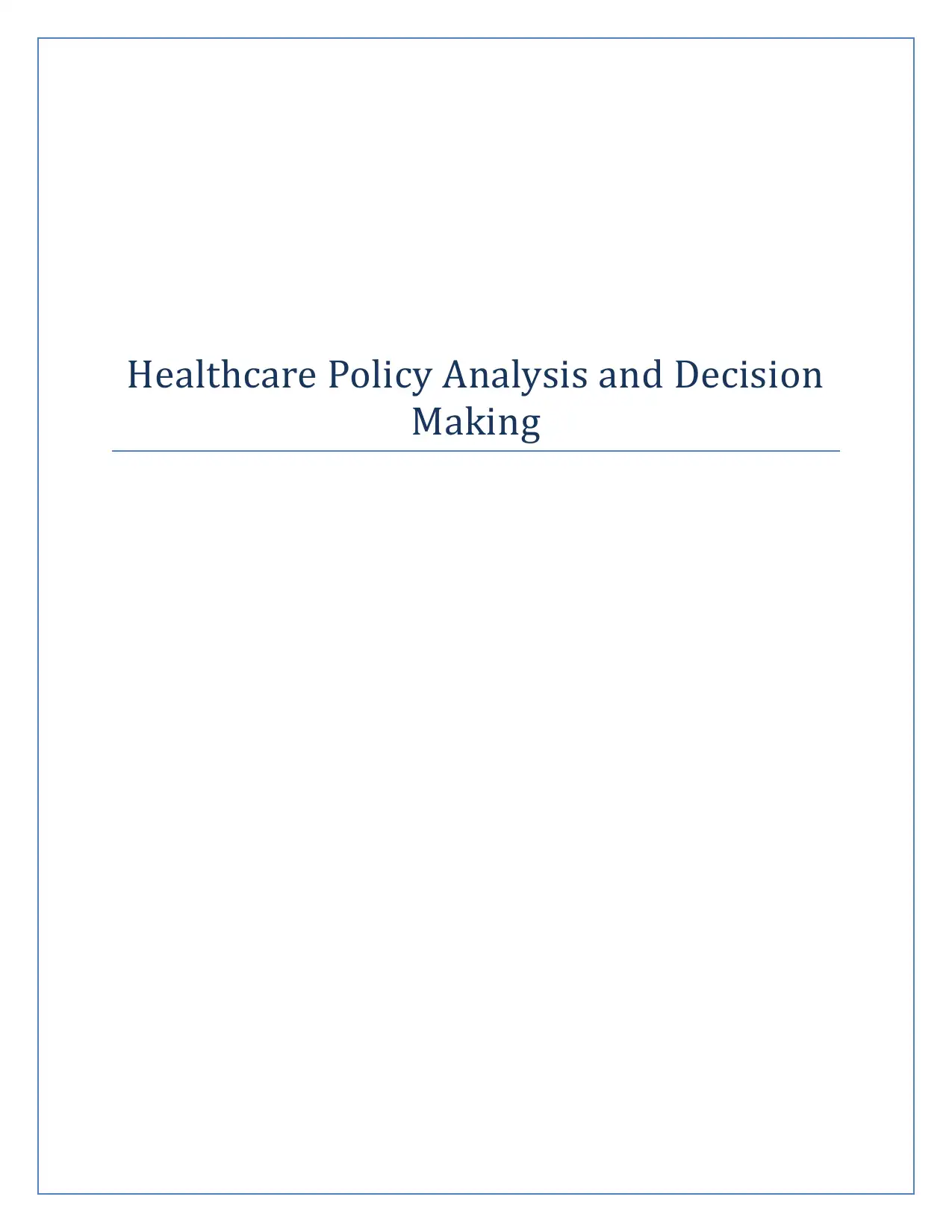
Healthcare Policy Analysis and Decision
Making
Making
Paraphrase This Document
Need a fresh take? Get an instant paraphrase of this document with our AI Paraphraser
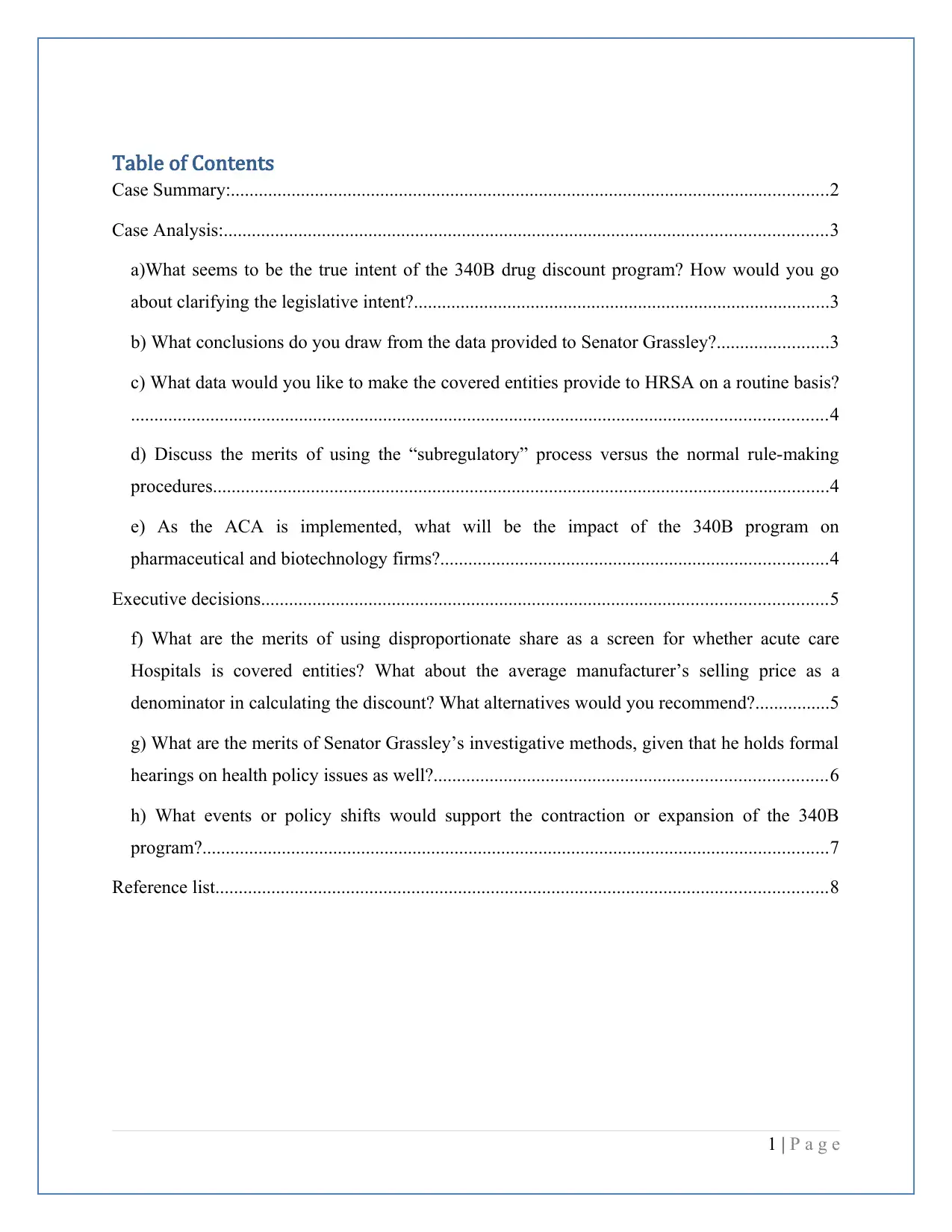
Table of Contents
Case Summary:................................................................................................................................2
Case Analysis:.................................................................................................................................3
a)What seems to be the true intent of the 340B drug discount program? How would you go
about clarifying the legislative intent?.........................................................................................3
b) What conclusions do you draw from the data provided to Senator Grassley?........................3
c) What data would you like to make the covered entities provide to HRSA on a routine basis?
.....................................................................................................................................................4
d) Discuss the merits of using the “subregulatory” process versus the normal rule-making
procedures....................................................................................................................................4
e) As the ACA is implemented, what will be the impact of the 340B program on
pharmaceutical and biotechnology firms?...................................................................................4
Executive decisions.........................................................................................................................5
f) What are the merits of using disproportionate share as a screen for whether acute care
Hospitals is covered entities? What about the average manufacturer’s selling price as a
denominator in calculating the discount? What alternatives would you recommend?................5
g) What are the merits of Senator Grassley’s investigative methods, given that he holds formal
hearings on health policy issues as well?....................................................................................6
h) What events or policy shifts would support the contraction or expansion of the 340B
program?......................................................................................................................................7
Reference list...................................................................................................................................8
1 | P a g e
Case Summary:................................................................................................................................2
Case Analysis:.................................................................................................................................3
a)What seems to be the true intent of the 340B drug discount program? How would you go
about clarifying the legislative intent?.........................................................................................3
b) What conclusions do you draw from the data provided to Senator Grassley?........................3
c) What data would you like to make the covered entities provide to HRSA on a routine basis?
.....................................................................................................................................................4
d) Discuss the merits of using the “subregulatory” process versus the normal rule-making
procedures....................................................................................................................................4
e) As the ACA is implemented, what will be the impact of the 340B program on
pharmaceutical and biotechnology firms?...................................................................................4
Executive decisions.........................................................................................................................5
f) What are the merits of using disproportionate share as a screen for whether acute care
Hospitals is covered entities? What about the average manufacturer’s selling price as a
denominator in calculating the discount? What alternatives would you recommend?................5
g) What are the merits of Senator Grassley’s investigative methods, given that he holds formal
hearings on health policy issues as well?....................................................................................6
h) What events or policy shifts would support the contraction or expansion of the 340B
program?......................................................................................................................................7
Reference list...................................................................................................................................8
1 | P a g e
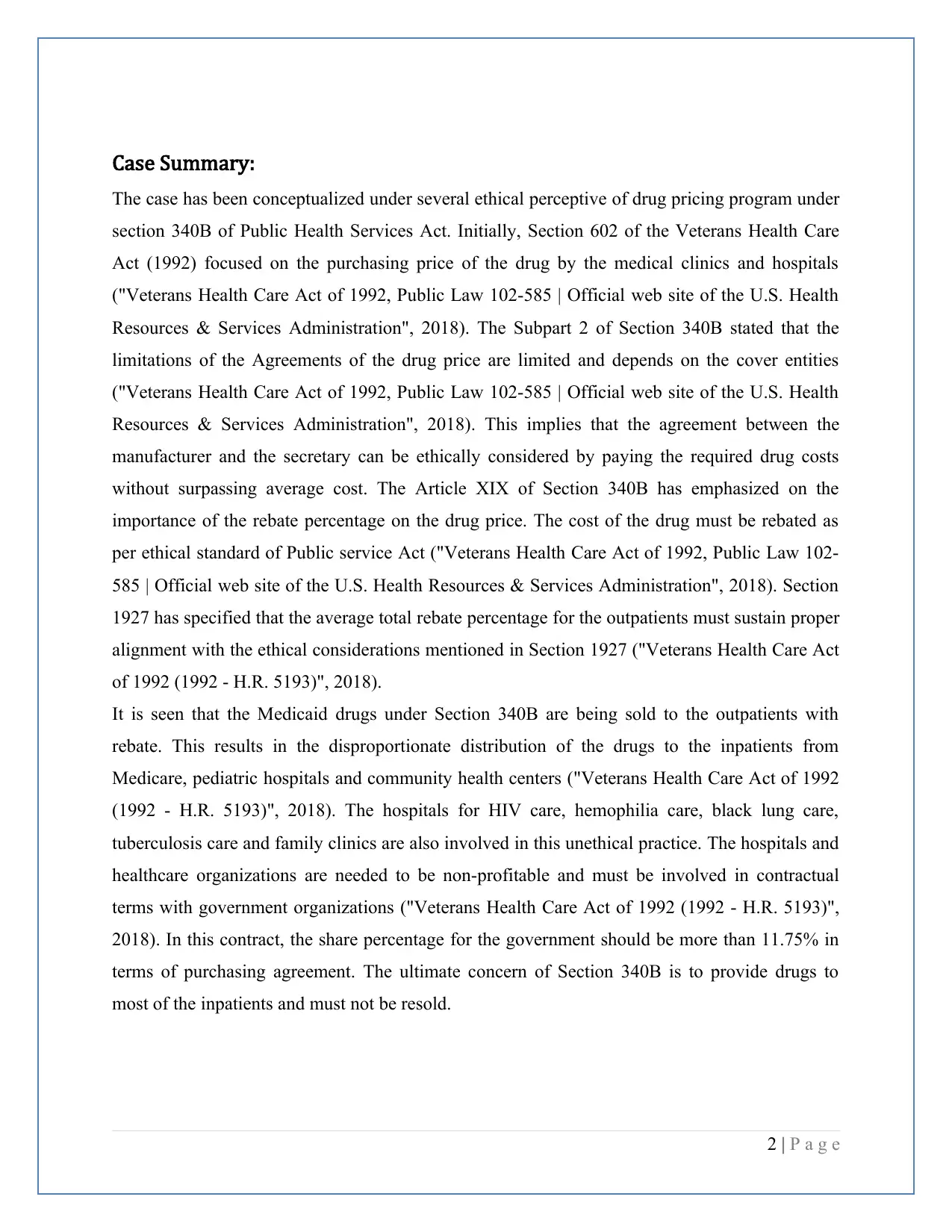
Case Summary:
The case has been conceptualized under several ethical perceptive of drug pricing program under
section 340B of Public Health Services Act. Initially, Section 602 of the Veterans Health Care
Act (1992) focused on the purchasing price of the drug by the medical clinics and hospitals
("Veterans Health Care Act of 1992, Public Law 102-585 | Official web site of the U.S. Health
Resources & Services Administration", 2018). The Subpart 2 of Section 340B stated that the
limitations of the Agreements of the drug price are limited and depends on the cover entities
("Veterans Health Care Act of 1992, Public Law 102-585 | Official web site of the U.S. Health
Resources & Services Administration", 2018). This implies that the agreement between the
manufacturer and the secretary can be ethically considered by paying the required drug costs
without surpassing average cost. The Article XIX of Section 340B has emphasized on the
importance of the rebate percentage on the drug price. The cost of the drug must be rebated as
per ethical standard of Public service Act ("Veterans Health Care Act of 1992, Public Law 102-
585 | Official web site of the U.S. Health Resources & Services Administration", 2018). Section
1927 has specified that the average total rebate percentage for the outpatients must sustain proper
alignment with the ethical considerations mentioned in Section 1927 ("Veterans Health Care Act
of 1992 (1992 - H.R. 5193)", 2018).
It is seen that the Medicaid drugs under Section 340B are being sold to the outpatients with
rebate. This results in the disproportionate distribution of the drugs to the inpatients from
Medicare, pediatric hospitals and community health centers ("Veterans Health Care Act of 1992
(1992 - H.R. 5193)", 2018). The hospitals for HIV care, hemophilia care, black lung care,
tuberculosis care and family clinics are also involved in this unethical practice. The hospitals and
healthcare organizations are needed to be non-profitable and must be involved in contractual
terms with government organizations ("Veterans Health Care Act of 1992 (1992 - H.R. 5193)",
2018). In this contract, the share percentage for the government should be more than 11.75% in
terms of purchasing agreement. The ultimate concern of Section 340B is to provide drugs to
most of the inpatients and must not be resold.
2 | P a g e
The case has been conceptualized under several ethical perceptive of drug pricing program under
section 340B of Public Health Services Act. Initially, Section 602 of the Veterans Health Care
Act (1992) focused on the purchasing price of the drug by the medical clinics and hospitals
("Veterans Health Care Act of 1992, Public Law 102-585 | Official web site of the U.S. Health
Resources & Services Administration", 2018). The Subpart 2 of Section 340B stated that the
limitations of the Agreements of the drug price are limited and depends on the cover entities
("Veterans Health Care Act of 1992, Public Law 102-585 | Official web site of the U.S. Health
Resources & Services Administration", 2018). This implies that the agreement between the
manufacturer and the secretary can be ethically considered by paying the required drug costs
without surpassing average cost. The Article XIX of Section 340B has emphasized on the
importance of the rebate percentage on the drug price. The cost of the drug must be rebated as
per ethical standard of Public service Act ("Veterans Health Care Act of 1992, Public Law 102-
585 | Official web site of the U.S. Health Resources & Services Administration", 2018). Section
1927 has specified that the average total rebate percentage for the outpatients must sustain proper
alignment with the ethical considerations mentioned in Section 1927 ("Veterans Health Care Act
of 1992 (1992 - H.R. 5193)", 2018).
It is seen that the Medicaid drugs under Section 340B are being sold to the outpatients with
rebate. This results in the disproportionate distribution of the drugs to the inpatients from
Medicare, pediatric hospitals and community health centers ("Veterans Health Care Act of 1992
(1992 - H.R. 5193)", 2018). The hospitals for HIV care, hemophilia care, black lung care,
tuberculosis care and family clinics are also involved in this unethical practice. The hospitals and
healthcare organizations are needed to be non-profitable and must be involved in contractual
terms with government organizations ("Veterans Health Care Act of 1992 (1992 - H.R. 5193)",
2018). In this contract, the share percentage for the government should be more than 11.75% in
terms of purchasing agreement. The ultimate concern of Section 340B is to provide drugs to
most of the inpatients and must not be resold.
2 | P a g e
⊘ This is a preview!⊘
Do you want full access?
Subscribe today to unlock all pages.

Trusted by 1+ million students worldwide
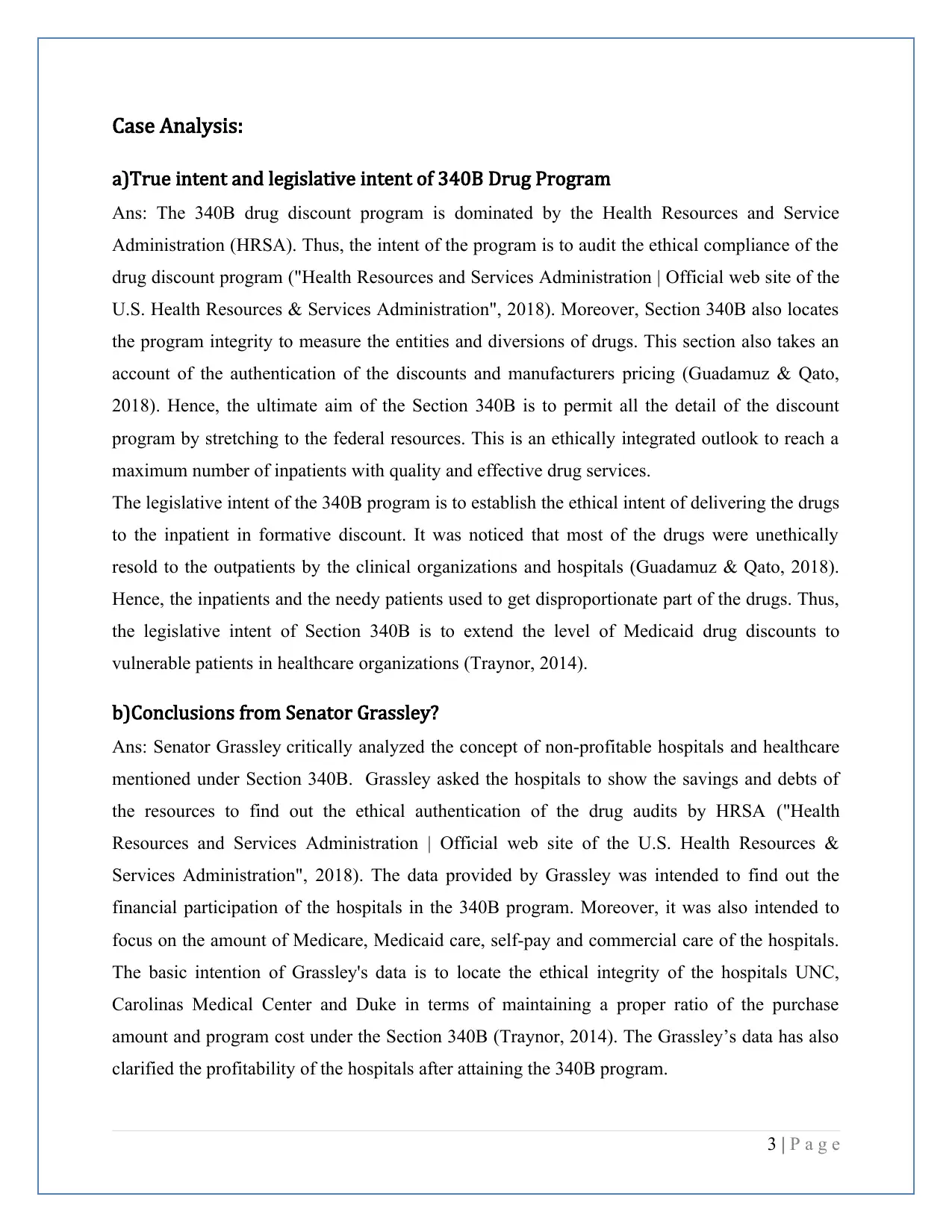
Case Analysis:
a)True intent and legislative intent of 340B Drug Program
Ans: The 340B drug discount program is dominated by the Health Resources and Service
Administration (HRSA). Thus, the intent of the program is to audit the ethical compliance of the
drug discount program ("Health Resources and Services Administration | Official web site of the
U.S. Health Resources & Services Administration", 2018). Moreover, Section 340B also locates
the program integrity to measure the entities and diversions of drugs. This section also takes an
account of the authentication of the discounts and manufacturers pricing (Guadamuz & Qato,
2018). Hence, the ultimate aim of the Section 340B is to permit all the detail of the discount
program by stretching to the federal resources. This is an ethically integrated outlook to reach a
maximum number of inpatients with quality and effective drug services.
The legislative intent of the 340B program is to establish the ethical intent of delivering the drugs
to the inpatient in formative discount. It was noticed that most of the drugs were unethically
resold to the outpatients by the clinical organizations and hospitals (Guadamuz & Qato, 2018).
Hence, the inpatients and the needy patients used to get disproportionate part of the drugs. Thus,
the legislative intent of Section 340B is to extend the level of Medicaid drug discounts to
vulnerable patients in healthcare organizations (Traynor, 2014).
b)Conclusions from Senator Grassley?
Ans: Senator Grassley critically analyzed the concept of non-profitable hospitals and healthcare
mentioned under Section 340B. Grassley asked the hospitals to show the savings and debts of
the resources to find out the ethical authentication of the drug audits by HRSA ("Health
Resources and Services Administration | Official web site of the U.S. Health Resources &
Services Administration", 2018). The data provided by Grassley was intended to find out the
financial participation of the hospitals in the 340B program. Moreover, it was also intended to
focus on the amount of Medicare, Medicaid care, self-pay and commercial care of the hospitals.
The basic intention of Grassley's data is to locate the ethical integrity of the hospitals UNC,
Carolinas Medical Center and Duke in terms of maintaining a proper ratio of the purchase
amount and program cost under the Section 340B (Traynor, 2014). The Grassley’s data has also
clarified the profitability of the hospitals after attaining the 340B program.
3 | P a g e
a)True intent and legislative intent of 340B Drug Program
Ans: The 340B drug discount program is dominated by the Health Resources and Service
Administration (HRSA). Thus, the intent of the program is to audit the ethical compliance of the
drug discount program ("Health Resources and Services Administration | Official web site of the
U.S. Health Resources & Services Administration", 2018). Moreover, Section 340B also locates
the program integrity to measure the entities and diversions of drugs. This section also takes an
account of the authentication of the discounts and manufacturers pricing (Guadamuz & Qato,
2018). Hence, the ultimate aim of the Section 340B is to permit all the detail of the discount
program by stretching to the federal resources. This is an ethically integrated outlook to reach a
maximum number of inpatients with quality and effective drug services.
The legislative intent of the 340B program is to establish the ethical intent of delivering the drugs
to the inpatient in formative discount. It was noticed that most of the drugs were unethically
resold to the outpatients by the clinical organizations and hospitals (Guadamuz & Qato, 2018).
Hence, the inpatients and the needy patients used to get disproportionate part of the drugs. Thus,
the legislative intent of Section 340B is to extend the level of Medicaid drug discounts to
vulnerable patients in healthcare organizations (Traynor, 2014).
b)Conclusions from Senator Grassley?
Ans: Senator Grassley critically analyzed the concept of non-profitable hospitals and healthcare
mentioned under Section 340B. Grassley asked the hospitals to show the savings and debts of
the resources to find out the ethical authentication of the drug audits by HRSA ("Health
Resources and Services Administration | Official web site of the U.S. Health Resources &
Services Administration", 2018). The data provided by Grassley was intended to find out the
financial participation of the hospitals in the 340B program. Moreover, it was also intended to
focus on the amount of Medicare, Medicaid care, self-pay and commercial care of the hospitals.
The basic intention of Grassley's data is to locate the ethical integrity of the hospitals UNC,
Carolinas Medical Center and Duke in terms of maintaining a proper ratio of the purchase
amount and program cost under the Section 340B (Traynor, 2014). The Grassley’s data has also
clarified the profitability of the hospitals after attaining the 340B program.
3 | P a g e
Paraphrase This Document
Need a fresh take? Get an instant paraphrase of this document with our AI Paraphraser
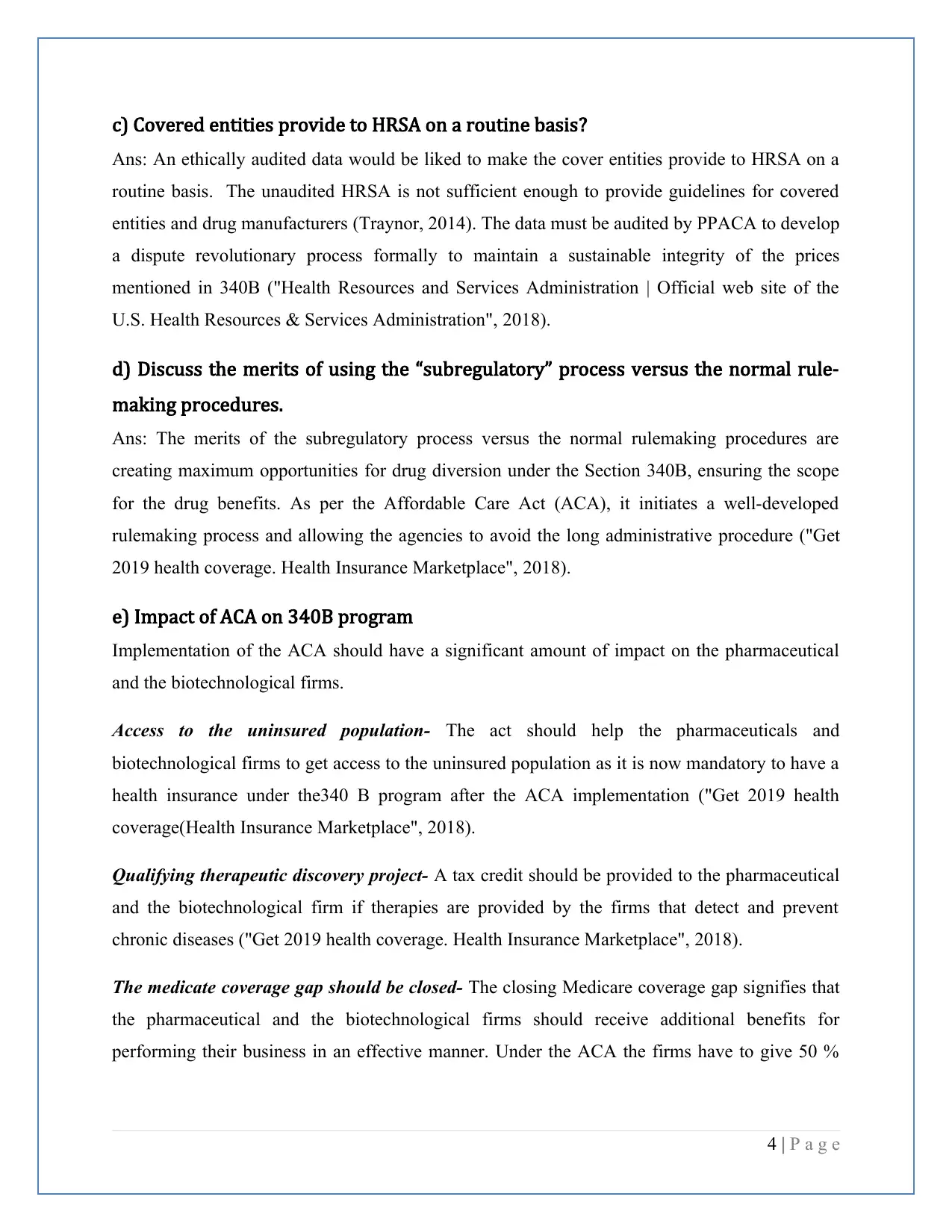
c) Covered entities provide to HRSA on a routine basis?
Ans: An ethically audited data would be liked to make the cover entities provide to HRSA on a
routine basis. The unaudited HRSA is not sufficient enough to provide guidelines for covered
entities and drug manufacturers (Traynor, 2014). The data must be audited by PPACA to develop
a dispute revolutionary process formally to maintain a sustainable integrity of the prices
mentioned in 340B ("Health Resources and Services Administration | Official web site of the
U.S. Health Resources & Services Administration", 2018).
d) Discuss the merits of using the “subregulatory” process versus the normal rule-
making procedures.
Ans: The merits of the subregulatory process versus the normal rulemaking procedures are
creating maximum opportunities for drug diversion under the Section 340B, ensuring the scope
for the drug benefits. As per the Affordable Care Act (ACA), it initiates a well-developed
rulemaking process and allowing the agencies to avoid the long administrative procedure ("Get
2019 health coverage. Health Insurance Marketplace", 2018).
e) Impact of ACA on 340B program
Implementation of the ACA should have a significant amount of impact on the pharmaceutical
and the biotechnological firms.
Access to the uninsured population- The act should help the pharmaceuticals and
biotechnological firms to get access to the uninsured population as it is now mandatory to have a
health insurance under the340 B program after the ACA implementation ("Get 2019 health
coverage(Health Insurance Marketplace", 2018).
Qualifying therapeutic discovery project- A tax credit should be provided to the pharmaceutical
and the biotechnological firm if therapies are provided by the firms that detect and prevent
chronic diseases ("Get 2019 health coverage. Health Insurance Marketplace", 2018).
The medicate coverage gap should be closed- The closing Medicare coverage gap signifies that
the pharmaceutical and the biotechnological firms should receive additional benefits for
performing their business in an effective manner. Under the ACA the firms have to give 50 %
4 | P a g e
Ans: An ethically audited data would be liked to make the cover entities provide to HRSA on a
routine basis. The unaudited HRSA is not sufficient enough to provide guidelines for covered
entities and drug manufacturers (Traynor, 2014). The data must be audited by PPACA to develop
a dispute revolutionary process formally to maintain a sustainable integrity of the prices
mentioned in 340B ("Health Resources and Services Administration | Official web site of the
U.S. Health Resources & Services Administration", 2018).
d) Discuss the merits of using the “subregulatory” process versus the normal rule-
making procedures.
Ans: The merits of the subregulatory process versus the normal rulemaking procedures are
creating maximum opportunities for drug diversion under the Section 340B, ensuring the scope
for the drug benefits. As per the Affordable Care Act (ACA), it initiates a well-developed
rulemaking process and allowing the agencies to avoid the long administrative procedure ("Get
2019 health coverage. Health Insurance Marketplace", 2018).
e) Impact of ACA on 340B program
Implementation of the ACA should have a significant amount of impact on the pharmaceutical
and the biotechnological firms.
Access to the uninsured population- The act should help the pharmaceuticals and
biotechnological firms to get access to the uninsured population as it is now mandatory to have a
health insurance under the340 B program after the ACA implementation ("Get 2019 health
coverage(Health Insurance Marketplace", 2018).
Qualifying therapeutic discovery project- A tax credit should be provided to the pharmaceutical
and the biotechnological firm if therapies are provided by the firms that detect and prevent
chronic diseases ("Get 2019 health coverage. Health Insurance Marketplace", 2018).
The medicate coverage gap should be closed- The closing Medicare coverage gap signifies that
the pharmaceutical and the biotechnological firms should receive additional benefits for
performing their business in an effective manner. Under the ACA the firms have to give 50 %
4 | P a g e
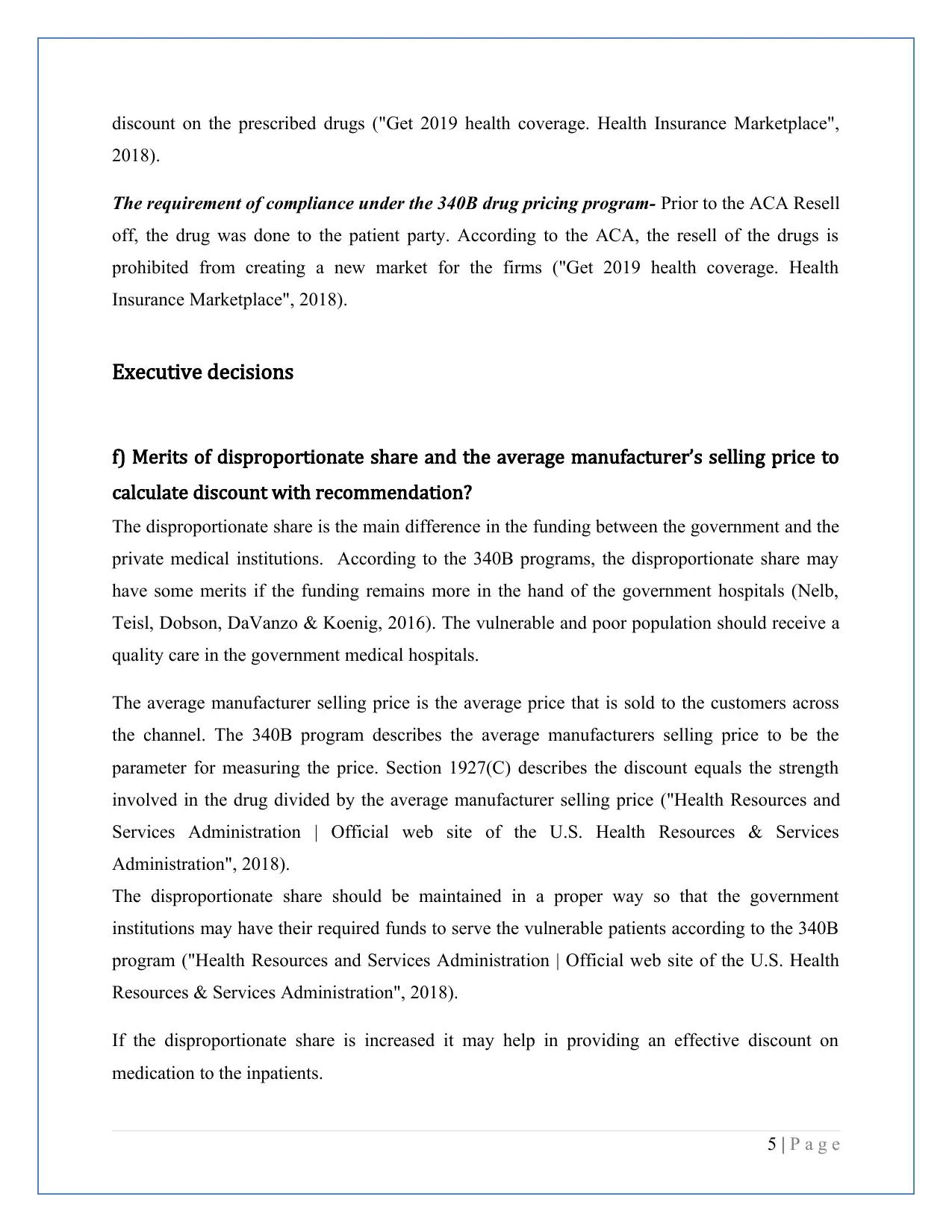
discount on the prescribed drugs ("Get 2019 health coverage. Health Insurance Marketplace",
2018).
The requirement of compliance under the 340B drug pricing program- Prior to the ACA Resell
off, the drug was done to the patient party. According to the ACA, the resell of the drugs is
prohibited from creating a new market for the firms ("Get 2019 health coverage. Health
Insurance Marketplace", 2018).
Executive decisions
f) Merits of disproportionate share and the average manufacturer’s selling price to
calculate discount with recommendation?
The disproportionate share is the main difference in the funding between the government and the
private medical institutions. According to the 340B programs, the disproportionate share may
have some merits if the funding remains more in the hand of the government hospitals (Nelb,
Teisl, Dobson, DaVanzo & Koenig, 2016). The vulnerable and poor population should receive a
quality care in the government medical hospitals.
The average manufacturer selling price is the average price that is sold to the customers across
the channel. The 340B program describes the average manufacturers selling price to be the
parameter for measuring the price. Section 1927(C) describes the discount equals the strength
involved in the drug divided by the average manufacturer selling price ("Health Resources and
Services Administration | Official web site of the U.S. Health Resources & Services
Administration", 2018).
The disproportionate share should be maintained in a proper way so that the government
institutions may have their required funds to serve the vulnerable patients according to the 340B
program ("Health Resources and Services Administration | Official web site of the U.S. Health
Resources & Services Administration", 2018).
If the disproportionate share is increased it may help in providing an effective discount on
medication to the inpatients.
5 | P a g e
2018).
The requirement of compliance under the 340B drug pricing program- Prior to the ACA Resell
off, the drug was done to the patient party. According to the ACA, the resell of the drugs is
prohibited from creating a new market for the firms ("Get 2019 health coverage. Health
Insurance Marketplace", 2018).
Executive decisions
f) Merits of disproportionate share and the average manufacturer’s selling price to
calculate discount with recommendation?
The disproportionate share is the main difference in the funding between the government and the
private medical institutions. According to the 340B programs, the disproportionate share may
have some merits if the funding remains more in the hand of the government hospitals (Nelb,
Teisl, Dobson, DaVanzo & Koenig, 2016). The vulnerable and poor population should receive a
quality care in the government medical hospitals.
The average manufacturer selling price is the average price that is sold to the customers across
the channel. The 340B program describes the average manufacturers selling price to be the
parameter for measuring the price. Section 1927(C) describes the discount equals the strength
involved in the drug divided by the average manufacturer selling price ("Health Resources and
Services Administration | Official web site of the U.S. Health Resources & Services
Administration", 2018).
The disproportionate share should be maintained in a proper way so that the government
institutions may have their required funds to serve the vulnerable patients according to the 340B
program ("Health Resources and Services Administration | Official web site of the U.S. Health
Resources & Services Administration", 2018).
If the disproportionate share is increased it may help in providing an effective discount on
medication to the inpatients.
5 | P a g e
⊘ This is a preview!⊘
Do you want full access?
Subscribe today to unlock all pages.

Trusted by 1+ million students worldwide
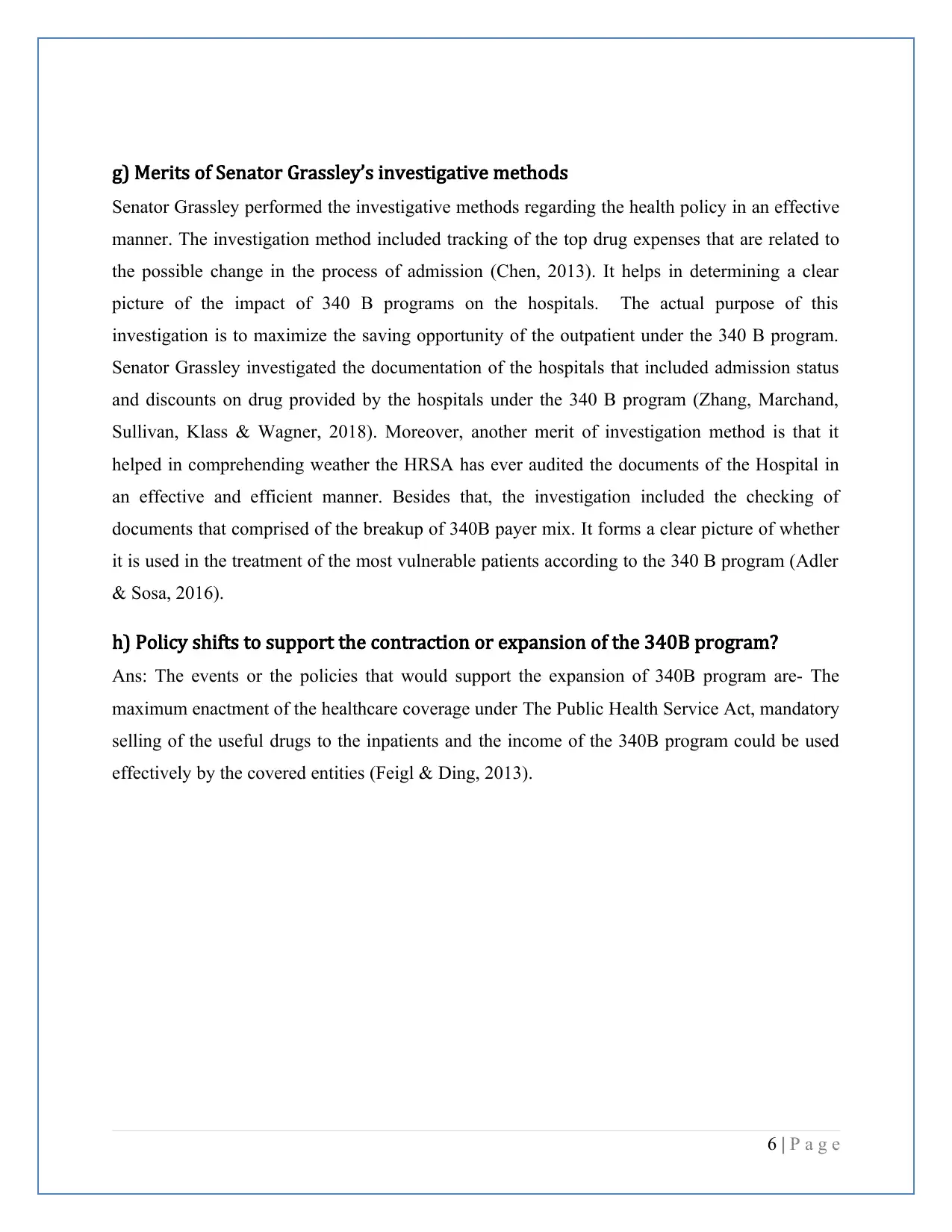
g) Merits of Senator Grassley’s investigative methods
Senator Grassley performed the investigative methods regarding the health policy in an effective
manner. The investigation method included tracking of the top drug expenses that are related to
the possible change in the process of admission (Chen, 2013). It helps in determining a clear
picture of the impact of 340 B programs on the hospitals. The actual purpose of this
investigation is to maximize the saving opportunity of the outpatient under the 340 B program.
Senator Grassley investigated the documentation of the hospitals that included admission status
and discounts on drug provided by the hospitals under the 340 B program (Zhang, Marchand,
Sullivan, Klass & Wagner, 2018). Moreover, another merit of investigation method is that it
helped in comprehending weather the HRSA has ever audited the documents of the Hospital in
an effective and efficient manner. Besides that, the investigation included the checking of
documents that comprised of the breakup of 340B payer mix. It forms a clear picture of whether
it is used in the treatment of the most vulnerable patients according to the 340 B program (Adler
& Sosa, 2016).
h) Policy shifts to support the contraction or expansion of the 340B program?
Ans: The events or the policies that would support the expansion of 340B program are- The
maximum enactment of the healthcare coverage under The Public Health Service Act, mandatory
selling of the useful drugs to the inpatients and the income of the 340B program could be used
effectively by the covered entities (Feigl & Ding, 2013).
6 | P a g e
Senator Grassley performed the investigative methods regarding the health policy in an effective
manner. The investigation method included tracking of the top drug expenses that are related to
the possible change in the process of admission (Chen, 2013). It helps in determining a clear
picture of the impact of 340 B programs on the hospitals. The actual purpose of this
investigation is to maximize the saving opportunity of the outpatient under the 340 B program.
Senator Grassley investigated the documentation of the hospitals that included admission status
and discounts on drug provided by the hospitals under the 340 B program (Zhang, Marchand,
Sullivan, Klass & Wagner, 2018). Moreover, another merit of investigation method is that it
helped in comprehending weather the HRSA has ever audited the documents of the Hospital in
an effective and efficient manner. Besides that, the investigation included the checking of
documents that comprised of the breakup of 340B payer mix. It forms a clear picture of whether
it is used in the treatment of the most vulnerable patients according to the 340 B program (Adler
& Sosa, 2016).
h) Policy shifts to support the contraction or expansion of the 340B program?
Ans: The events or the policies that would support the expansion of 340B program are- The
maximum enactment of the healthcare coverage under The Public Health Service Act, mandatory
selling of the useful drugs to the inpatients and the income of the 340B program could be used
effectively by the covered entities (Feigl & Ding, 2013).
6 | P a g e
Paraphrase This Document
Need a fresh take? Get an instant paraphrase of this document with our AI Paraphraser
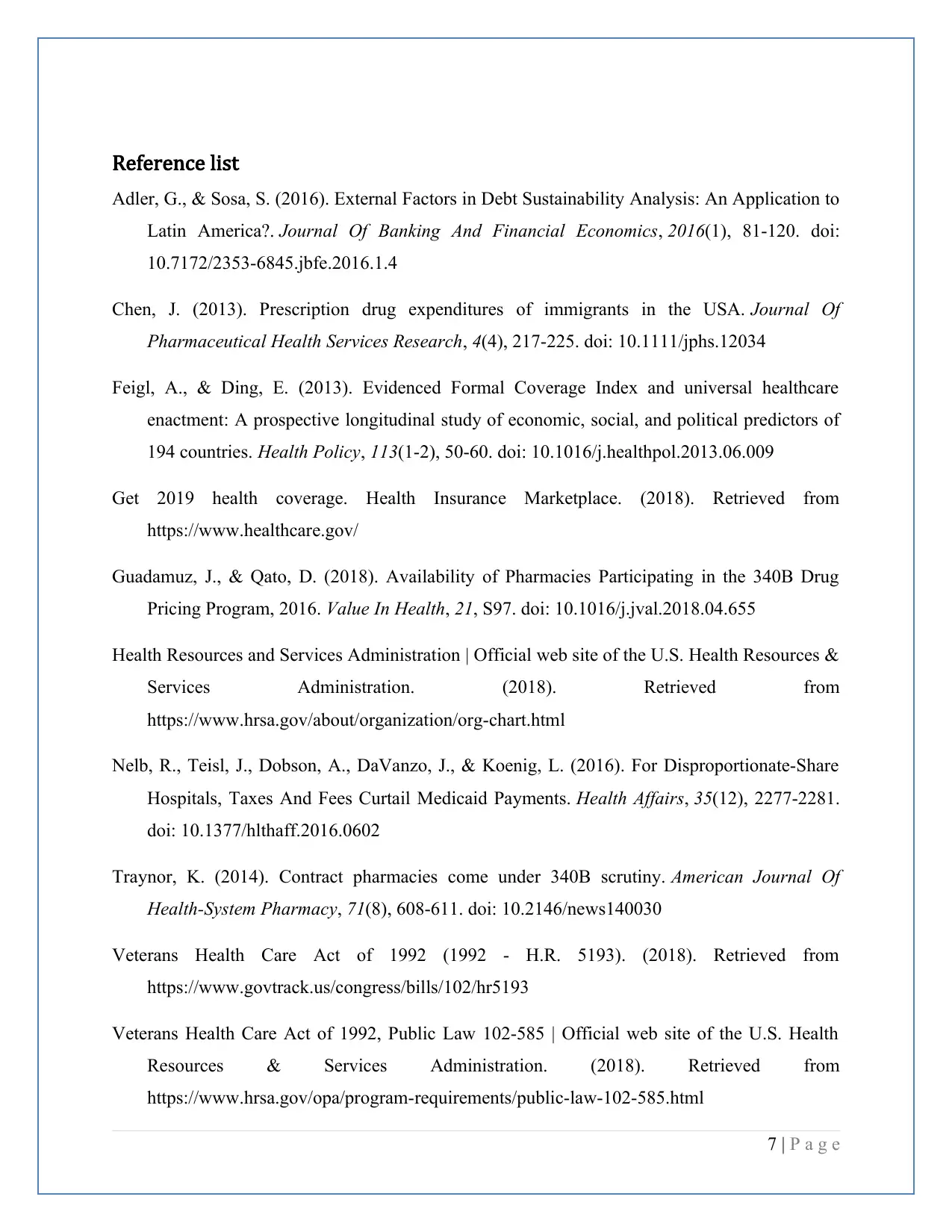
Reference list
Adler, G., & Sosa, S. (2016). External Factors in Debt Sustainability Analysis: An Application to
Latin America?. Journal Of Banking And Financial Economics, 2016(1), 81-120. doi:
10.7172/2353-6845.jbfe.2016.1.4
Chen, J. (2013). Prescription drug expenditures of immigrants in the USA. Journal Of
Pharmaceutical Health Services Research, 4(4), 217-225. doi: 10.1111/jphs.12034
Feigl, A., & Ding, E. (2013). Evidenced Formal Coverage Index and universal healthcare
enactment: A prospective longitudinal study of economic, social, and political predictors of
194 countries. Health Policy, 113(1-2), 50-60. doi: 10.1016/j.healthpol.2013.06.009
Get 2019 health coverage. Health Insurance Marketplace. (2018). Retrieved from
https://www.healthcare.gov/
Guadamuz, J., & Qato, D. (2018). Availability of Pharmacies Participating in the 340B Drug
Pricing Program, 2016. Value In Health, 21, S97. doi: 10.1016/j.jval.2018.04.655
Health Resources and Services Administration | Official web site of the U.S. Health Resources &
Services Administration. (2018). Retrieved from
https://www.hrsa.gov/about/organization/org-chart.html
Nelb, R., Teisl, J., Dobson, A., DaVanzo, J., & Koenig, L. (2016). For Disproportionate-Share
Hospitals, Taxes And Fees Curtail Medicaid Payments. Health Affairs, 35(12), 2277-2281.
doi: 10.1377/hlthaff.2016.0602
Traynor, K. (2014). Contract pharmacies come under 340B scrutiny. American Journal Of
Health-System Pharmacy, 71(8), 608-611. doi: 10.2146/news140030
Veterans Health Care Act of 1992 (1992 - H.R. 5193). (2018). Retrieved from
https://www.govtrack.us/congress/bills/102/hr5193
Veterans Health Care Act of 1992, Public Law 102-585 | Official web site of the U.S. Health
Resources & Services Administration. (2018). Retrieved from
https://www.hrsa.gov/opa/program-requirements/public-law-102-585.html
7 | P a g e
Adler, G., & Sosa, S. (2016). External Factors in Debt Sustainability Analysis: An Application to
Latin America?. Journal Of Banking And Financial Economics, 2016(1), 81-120. doi:
10.7172/2353-6845.jbfe.2016.1.4
Chen, J. (2013). Prescription drug expenditures of immigrants in the USA. Journal Of
Pharmaceutical Health Services Research, 4(4), 217-225. doi: 10.1111/jphs.12034
Feigl, A., & Ding, E. (2013). Evidenced Formal Coverage Index and universal healthcare
enactment: A prospective longitudinal study of economic, social, and political predictors of
194 countries. Health Policy, 113(1-2), 50-60. doi: 10.1016/j.healthpol.2013.06.009
Get 2019 health coverage. Health Insurance Marketplace. (2018). Retrieved from
https://www.healthcare.gov/
Guadamuz, J., & Qato, D. (2018). Availability of Pharmacies Participating in the 340B Drug
Pricing Program, 2016. Value In Health, 21, S97. doi: 10.1016/j.jval.2018.04.655
Health Resources and Services Administration | Official web site of the U.S. Health Resources &
Services Administration. (2018). Retrieved from
https://www.hrsa.gov/about/organization/org-chart.html
Nelb, R., Teisl, J., Dobson, A., DaVanzo, J., & Koenig, L. (2016). For Disproportionate-Share
Hospitals, Taxes And Fees Curtail Medicaid Payments. Health Affairs, 35(12), 2277-2281.
doi: 10.1377/hlthaff.2016.0602
Traynor, K. (2014). Contract pharmacies come under 340B scrutiny. American Journal Of
Health-System Pharmacy, 71(8), 608-611. doi: 10.2146/news140030
Veterans Health Care Act of 1992 (1992 - H.R. 5193). (2018). Retrieved from
https://www.govtrack.us/congress/bills/102/hr5193
Veterans Health Care Act of 1992, Public Law 102-585 | Official web site of the U.S. Health
Resources & Services Administration. (2018). Retrieved from
https://www.hrsa.gov/opa/program-requirements/public-law-102-585.html
7 | P a g e
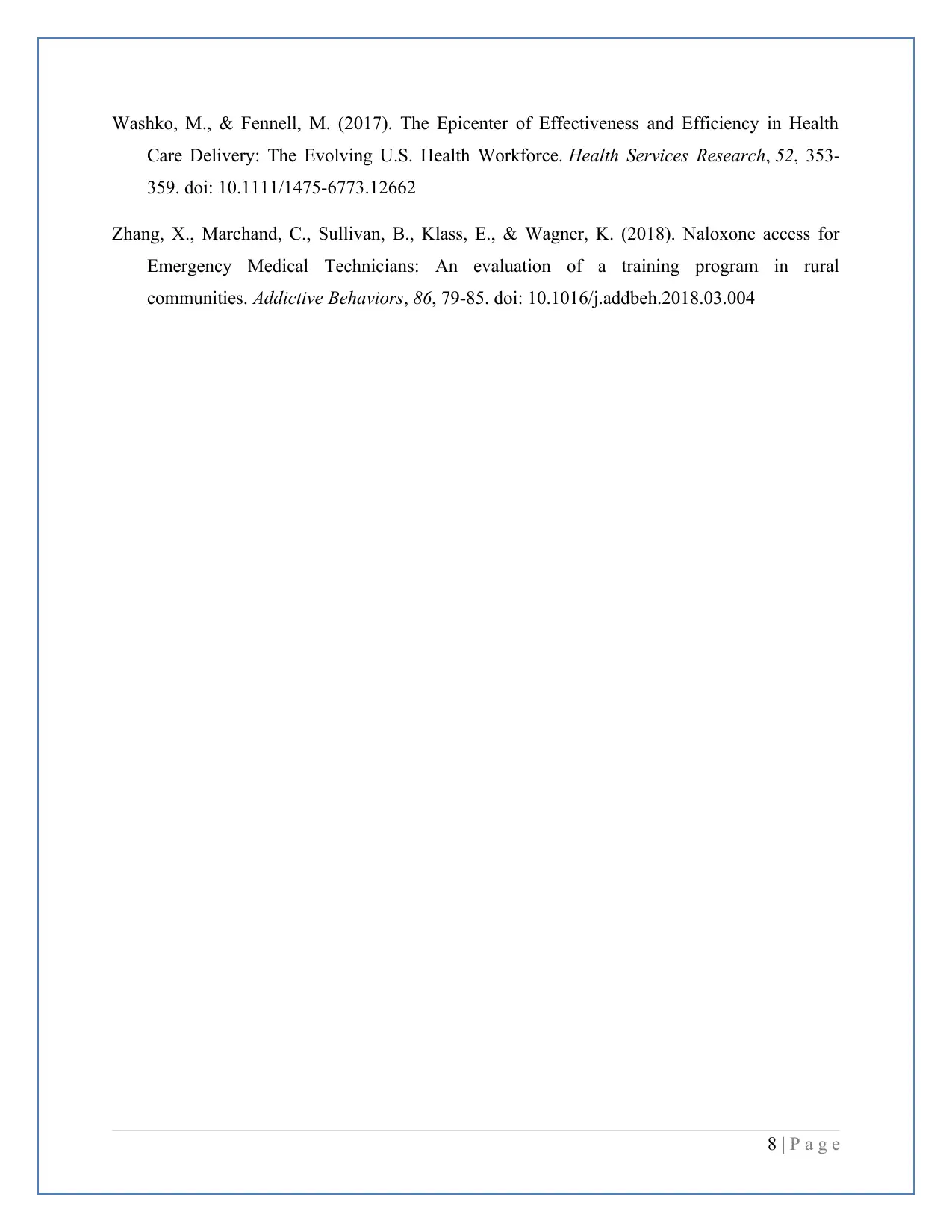
Washko, M., & Fennell, M. (2017). The Epicenter of Effectiveness and Efficiency in Health
Care Delivery: The Evolving U.S. Health Workforce. Health Services Research, 52, 353-
359. doi: 10.1111/1475-6773.12662
Zhang, X., Marchand, C., Sullivan, B., Klass, E., & Wagner, K. (2018). Naloxone access for
Emergency Medical Technicians: An evaluation of a training program in rural
communities. Addictive Behaviors, 86, 79-85. doi: 10.1016/j.addbeh.2018.03.004
8 | P a g e
Care Delivery: The Evolving U.S. Health Workforce. Health Services Research, 52, 353-
359. doi: 10.1111/1475-6773.12662
Zhang, X., Marchand, C., Sullivan, B., Klass, E., & Wagner, K. (2018). Naloxone access for
Emergency Medical Technicians: An evaluation of a training program in rural
communities. Addictive Behaviors, 86, 79-85. doi: 10.1016/j.addbeh.2018.03.004
8 | P a g e
⊘ This is a preview!⊘
Do you want full access?
Subscribe today to unlock all pages.

Trusted by 1+ million students worldwide
1 out of 9
Your All-in-One AI-Powered Toolkit for Academic Success.
+13062052269
info@desklib.com
Available 24*7 on WhatsApp / Email
![[object Object]](/_next/static/media/star-bottom.7253800d.svg)
Unlock your academic potential
Copyright © 2020–2025 A2Z Services. All Rights Reserved. Developed and managed by ZUCOL.
